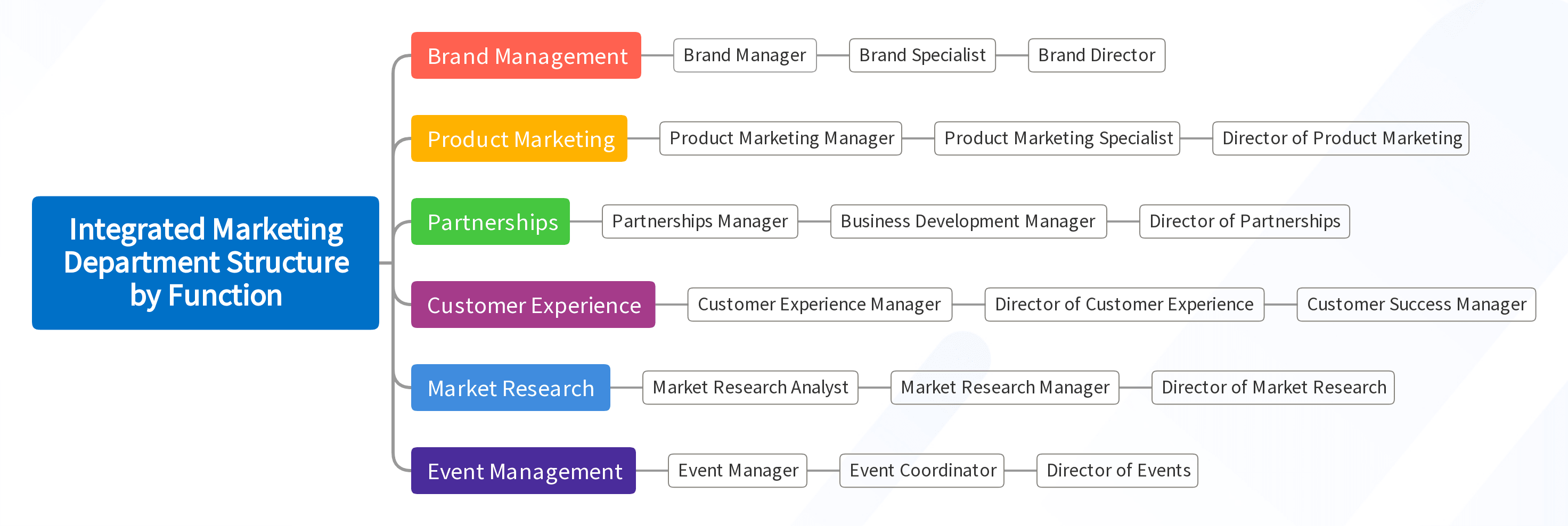

Integrated Marketing teams are essential in modern businesses. They harmonize various strategies to achieve corporate goals.
Understanding their structure is pivotal. It helps grasp how they function and contribute to business success. My partners and I have been running our own marketing agency for years so I can tell you what actually works.
But first, let's talk about the Integrated Marketing department structures you have to choose from.
Best for Growth Marketers
Best for Paid Ads & CMO's
Table of Contents
Structuring Integrated Marketing Department
There are two main types of department structures based on company size and resources.
- Integrated Marketing department structure by discipline
- Org Type: Traditional corporate departments
- Best For: Midsize/Enterprise companies
- Integrated Marketing department structure by function
- Org Type: Employees are grouped by activities and objectives
- Best For: Small to Medium Sized Business (SMB)
Let’s go in-depth to each one of them.
1. Integrated Marketing Department Structure by Discipline


Discipline-based structure involves building teams centered around various marketing disciplines. For example, SEO, Content, Market Research, and Product Strategy could each form separate teams within a department.
| Discipline | Key Skills | Potential Roles |
|---|---|---|
| Content | Copywriting, SEO, Storytelling, Research, Editing | Content Manager, Editor, SEO Specialist |
| Social Media | Community Management, Content Creation, Analytics, Trend Spotting, Advertising | Social Media Manager, Community Manager, Social Media Specialist |
| Email Marketing | Copywriting, Analytics, CRM, A/B Testing, Segmentation | Email Marketing Manager, CRM Specialist, Email Designer |
| PR & Communications | Public Speaking, Crisis Management, Networking, Writing, Media Relations | Public Relations Manager, Communications Specialist, PR Coordinator |
| SEO | Keyword Research, On-page SEO, Link Building, Analytics, Technical SEO | SEO Manager, SEO Analyst, SEO Consultant |
| Design | Graphic Design, UI/UX Design, Branding, Typography, Adobe Creative Suite | Graphic Designer, UX Designer, Creative Director |
| Analytics | Data Analysis, Google Analytics, Reporting, A/B Testing, Data Visualization | Data Analyst, Marketing Analyst, Analytics Manager |
| Strategy | Market Research, Competitive Analysis, Strategic Planning, Brand Strategy, Budgeting | Marketing Strategist, Brand Manager, Chief Marketing Officer |
2. Integrated Marketing Department Structure by Function


Another approach is structuring by function, where teams are formed based on the different functions they perform. For example, promotion, launches, and relationship management could all be separate teams.
| Function | Key Skills | Potential Roles |
|---|---|---|
| Brand Management | Brand Strategy, Market Research, Customer Insights, Positioning, Brand Development | Brand Manager, Brand Specialist, Brand Director |
| Product Marketing | Product Knowledge, Market Intelligence, Competitive Analysis, Cross-Functional Collaboration, Positioning | Product Marketing Manager, Product Marketing Specialist, Director of Product Marketing |
| Partnerships | Relationship Building, Strategic Planning, Negotiation, Collaboration, Business Development | Partnerships Manager, Business Development Manager, Director of Partnerships |
| Customer Experience | Customer Journey Mapping, Customer Feedback Analysis, UX Design, Data Analysis, CRM | Customer Experience Manager, Director of Customer Experience, Customer Success Manager |
| Market Research | Data Analysis, Survey Design, Research Skills, Consumer Behavior, Statistical Analysis | Market Research Analyst, Market Research Manager, Director of Market Research |
| Event Management | Event Planning, Vendor Management, Budgeting, Creativity, Public Relations | Event Manager, Event Coordinator, Director of Events |
Integrated Marketing Team Size versus Business Scale
To achieve successful marketing outcomes, you need to align the team size with your business's scale – a strategic approach that helps optimize resources and drive targeted growth.
| Business Scale | Ideal Department Size | Explanation |
|---|---|---|
| Start-up | 1-3 | Resource constraints and less complexity. |
| Small-Medium Business | 4-10 | Diverse needs but manageable operations. |
| Large Enterprise | 11+ | High complexity and larger market presence. |
Factors to Consider When Deciding On an Integrated Marketing Department Structure
- Business Goals: Define your objectives clearly. Whether it's building brand awareness, increasing sales, or engaging customers, your marketing department should align with these goals.
- Target Audience: Understand who your customers are. Creating a marketing team that can effectively communicate with your target demographic is crucial for success.
- Available Resources: Consider your assets. This includes both financial resources and human capital. The size and competencies of your team should reflect what's available.
- Market Trends: Stay updated with the latest industry trends. Your marketing department should be dynamic and flexible enough to adapt to changes in the market.
- Internal Communication: Ensure smooth collaboration. A well-structured department should facilitate easy communication and cooperation between team members to execute integrated marketing strategies effectively.
Explore other marketing departments:
So, there you have it, a detailed overview of an Integrated Marketing team structure. From the essence of the team and key roles, to structuring and optimizing; every aspect tailored to achieve success on your business blueprint.




















